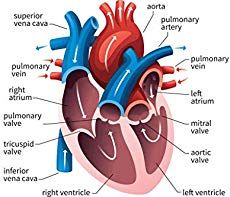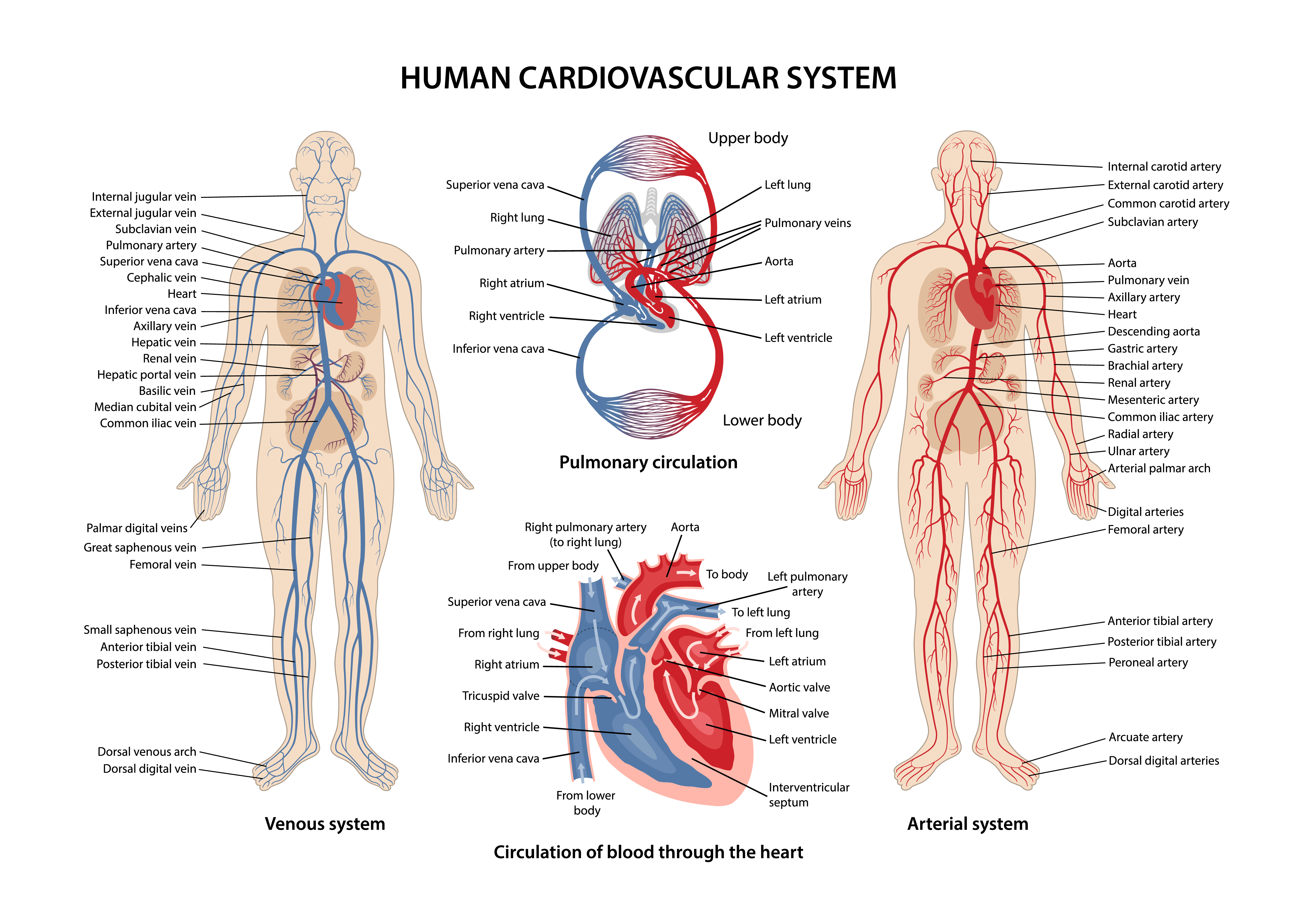In my article: What is the Central Nervous System, I promised to write about all the systems of the body. I have since posted articles on: the endocrine system and the digestive system. This article is about the cardiovascular system. The purpose is to cover all about the cardiovascular system.
What is the Cardiovascular System
The vascular system, additionally referred to as the cardiovascular system, is a system that permits blood to circulate and transport nutrients (such as amino acids and electrolytes), oxygen, carbon dioxide, hormones, and blood cells to and from the cells within the body to supply nourishment and facilitate in fighting diseases, stabilize temperature and pH, and maintain
homeostasis.
The cardiovascular system includes the vascular system, that circulates Lymph. The passage of lymph takes much longer than that of blood. Lymph is essentially recycled excess blood plasma after it has been filtered from the interstitial fluid (contained between cells) and returned to the lymphatic system.
Organs of the cardiovascular system
The cardiovascular (from Latin words meaning “heart” and “vessel”) system is comprised of the blood, heart, and blood vessels. The lymph, lymph nodes, and Lymph vessels form the lymphatic system, which returns filtered blood plasma from the interstitial fluid (between cells) as lymph. More on the lymph system in a future article. Below is a description of these organs.
Heart – the heart pumps oxygen rich blood to the body and deoxygenated blood to the lungs.

The heart is comprised of a single atrium and one ventricle for each and every circulation, and with both a systemic and a pulmonary circulation there are four chambers in total: left atrium, left ventricle, right atrium and right ventricle. The right atrium is the higher chamber of the right side of the heart. The blood that is returned to the right atrium is deoxygenated (deprived of oxygen) and passed into the right ventricle to be pumped through the pulmonary artery to the lungs for re-oxygenation and removal of carbon dioxide. The left atrium of the heart receives recently aerated blood from the lungs as well as the pulmonary vein which is passed into the robust ventricle to be pumped through the aorta to the different organs of the body.
Blood – A fluid consisting of plasma, red blood cells, white blood cells, and platelets that is circulated by the heart through the vascular system, carrying oxygen and nutrients to and waste materials off from all body tissues.

Blood is the river of life to the body serving as a transport system for oxygen and nutrients and waste materials. The circulatory system of the blood is seen as having two components, a systemic circulation and a pulmonary circulation which is a loop through the lungs where blood is oxygenated; and the systemic circulation through the rest of the body to provide oxygenated blood.
The cardiovascular systems of humans are closed, meaning that the blood never leaves the network of blood vessels. In contrast, the other component of the circulatory system, the lymphatic system, is open.
The blood is circulated through a network known as blood vessels; more specifically arteries and veins.
Arteries – Arteries carry blood away from the heart and are the thickest blood vessels. The walls continually contract to keep the blood moving. These walls have three layers, a tough covering, a layer of muscle and stretchy tissue and a smooth lining for blood flow. The aorta is the largest of the arteries, connecting to the heart, and then branching off into two main coronary arteries and networks of smaller vessels. The pulmonary artery carries blood lacking oxygen to the lungs to be oxygenated, and then back to the heart.
Veins – Veins carry blood back to the heart. Veins contain valves that keep the blood flowing. Tiny capillaries connect arteries and veins, exchanging nutrients and oxygen to cells and removing waste like carbon dioxide. Veins are thinner and less flexible than arteries. However they do have three wall layers similarly. Valves can work improperly, causing blood to pool and form varicose veins, which appear as bumps or protrude out from the skin.
Common diseases of the cardiovascular system
Atherosclerosis – This is a hardening of the arteries. It is typically caused by a high fat diet, which leaves fatty deposits in the lining of the blood vessels. This is the result of high cholesterol in the blood. These fatty deposits stick together and make the arteries hardened and less flexible.
Atherosclerosis leads to hypertension (high blood pressure), which can damage the heart and kidneys and even lead to strokes.
Heart attack – Myocardial infarction (MI) is the technical term for this condition. An attack will occur once the blood supply is discontinued from the heart, often by a blood clot. Some heart attacks can be minor; however others can be life-threatening.
Mitral valve prolapsed – The mitral valve pumps freshly oxygenated blood out of the heart to the rest of the body. Mitral valve prolapse means the mitral valve bulges out or prolapses because it does not close evenly.
Mitral valve regurgitation – Mitral valve regurgitation happens when the mitral valve doesn’t close all the way and causes a leak, allowing some of the oxygenated blood to flow backward.
Mitral stenosis – Mitral stenosis occurs when the mitral valve is abnormally narrow which can prevent the blood from flowing smoothly or quickly through it.
Angina pectoris – Commonly referred to simply as Angina, Angina pectoris means “pain in the chest” and occurs if the heart is not receiving enough blood. People usually describe it as a crushing sensation or feeling like their chest is in an exceedingly strong vice. People with angina pectoris might also feel breathless, tired, and nauseated.
Arrhythmia and dysrhythmia – Arrhythmia and dysrhythmia are generally used interchangeably, and both refer to abnormal heart rates and rhythms.
Cardiac Ischemia – Cardiac ischemia means the heart muscle is not getting enough oxygen to function properly. A person with cardiac ischemia will typically experience angina-like pain and will feel like they’re having an attack.
Heart failure – Heart failure, also known as congestive heart failure, means that the heart is not pumping blood as efficiently around the body as it should. It can lead to fatigue, shortness of breath, and coughing. Some people with heart failure find it difficult to do regular everyday things such as walking, climbing stairs, or carrying groceries.
High blood pressure (hypertension) – High blood pressure or hypertension means the force or pressure of the blood flowing through the vessels is consistently too high causing increased pressure on the vessel. If high, this vital sign can cause stroke, loss of vision, heart failure, heart attack, kidney disease, and reduced sexual function.
Stroke – A stroke can occur when one of the vessels that lead to the brain either becomes blocked by a blood clot or bursts. This stops blood flow and prevents oxygen and other nutrients from arriving in the brain. Strokes can lead to serious consequences if not treated quickly. These include speech and language impediments and paralysis from varying degrees to totally.
Peripheral artery sickness (PAD) – refers to narrowing of the arteries that lead to
the legs, stomach, arms, and head. This reduced blood flow will harm the cells and tissues within the limbs, organs, and brain. This condition tends to occur more often in older people.
Venous thromboembolism (VTE) – is a blood clot that gets stuck in a vein, blocking the flow of blood. It is a highly critical condition that requires emergency medical attention.
Aortic aneurysms – Aortic aneurysms affect the main artery in the body. It occurs when the artery wall has weakened, allowing it to widen or balloon out. An enlarged artery could burst and become a total medical emergency.
Can cardiovascular disease be prevented
While scientists may not know what causes all of these diseases, there are things that individuals can do to reduce the risk of developing them. Many cardiovascular system diseases are linked to each other. For example, high blood pressure damages the blood vessels, which can lead to other circulatory problems. The narrowing of blood vessels caused by high cholesterol intensifies the likelihood of a person getting a blood clot. Being overweight or obese will increase the chance of developing circulatory diseases.
However, a healthful diet and being active will scale back the danger. Regular exercise keeps the heart healthy by reducing the danger of hypertension (high blood pressure), high cholesterol, and being overweight — all of which are risk factors for cardiovascular diseases.
Smoking could be an important risk issue for developing circulatory diseases. Toxic substances in tobacco can constrict and harm the blood vessels, increasing the risk of blood clots and causing poor circulation.
People who have members of the family with a circulatory infirmity are more likely to develop one themselves. This risk, however, is reduced with a healthful way of life.
A point to remember:
Some circulatory diseases such as: heart attacks, stroke, and busted aneurysms, are life-threatening and need emergency medical attention.
Anyone who experiences heart pain is advised to make an appointment with their doctor promptly. Individuals who are concerned that they are at risk of developing a circulatory disease can ask their doctor how to make healthful lifestyle changes.
Good Health!
Please feel free to leave any question or comment below.
Thank you for this great article. The cardiovascular system is an important subject since it’s something we all have, and we all want to have as healthy as possible. Your knowledge of all the scientific factors within the cardiovascular system is very extensive. It is important for everyone to understand, so they can take the best care of themselves. The images and diagrams are especially helpful in visualizing this complicated subject.
Hi C – Glad you’ve enjoyed the post. My goal is to post about all the systems of our body. This is the third one, so stay tuned! Thanks for stopping by and commenting!
Great post you have written here and I can only say that this is like taking biology classes because I learnt quite so well about cardiovascular and the various components attached to it. This is really interesting to know the issues that lead to various heart disease and the measures that s scienifically advised to take to counter them. Thanks you so much. Your website has become the best possible place to learn about health for me.
Hi Rodarrick! Always good to hear from you and I’m glad you’re enjoying the website. More to come!
This is more than enough for anyone to have the full knowledge about how cardiovascular works. I have not been a big fan of science classes but I always like the set up of the cardiovascular exercises. Great one here. Knowing about all the health details suroundingour heart and the best ways to make sure w stay on top in all situations. Worthy of a read.
Thanks for your comment Bella. I appreciate it!